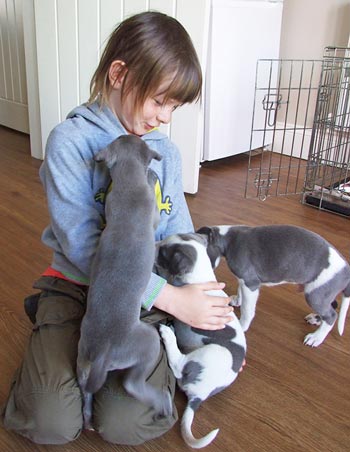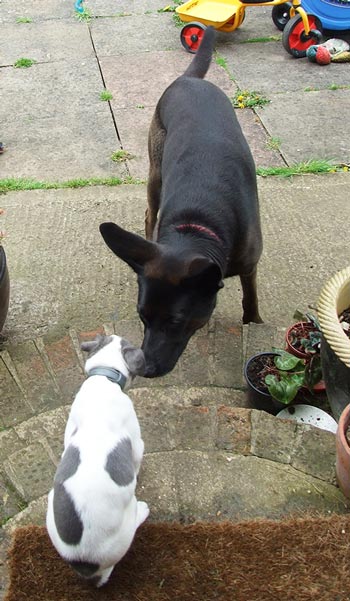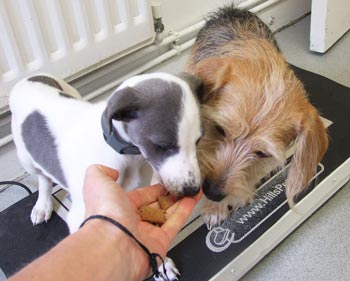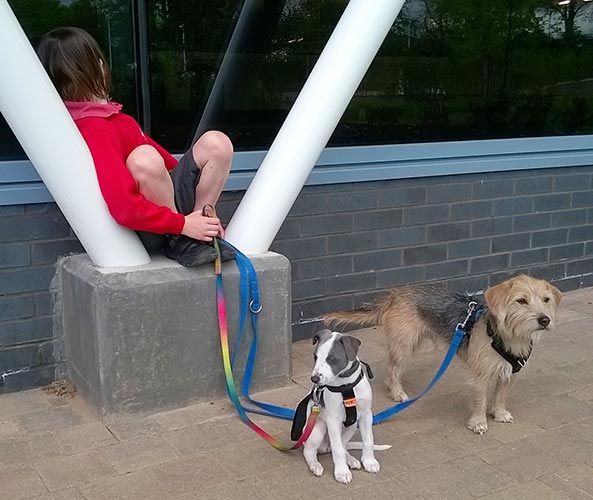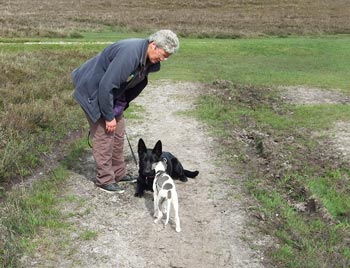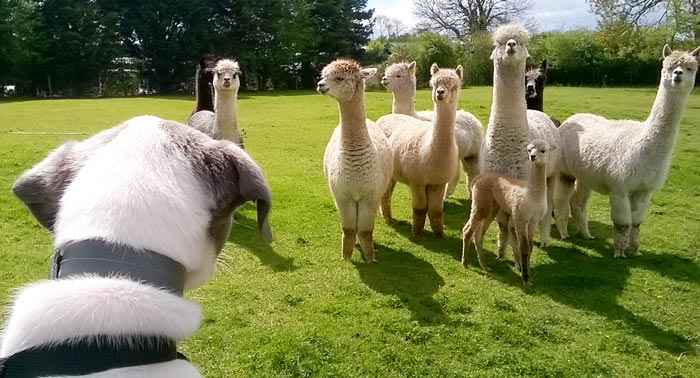31 Jul 2017
Where are we going wrong with socialisation advice?
Clare Wilson discusses the importance of puppy socialisation in fostering desired behaviour to take through to adult life.

Figure 4. Feeding treats forms good associations.
In 2016, the BVA published a concerning press release reporting 98% of vets had been asked to euthanise healthy pets for behavioural reasons (BVA, 2016). However, many of these problems, which lead to such a drastic outcome, are preventable with appropriate early intervention.

The BVA stated “these figures overwhelmingly show the importance of adequate early socialisation of animals at an early age”. This article aims to give general practitioners the confidence to provide clients with essential information for bringing up their puppies to be well-adjusted adult dogs.
Socialisation is a well-known term among the veterinary profession and public, but a lack of understanding exists for how to apply this to the practicalities of everyday life. Inadequate early socialisation or poor enrichment have long-term effects, such as abnormal fear responses, social inadequacies, hyperactivity, increased aggression and decreased learning ability.
Puppies must be actively socialised before 12 weeks of age (Seksel, 2010). Behavioural organisation of the brain is affected during this early time and cannot be easily reversed by behaviour modification later in life (Champagne and Curley, 2005). Each puppy is unique, and its experiences and education must be tailored to its individual responses. This relies on an understanding of the learning processes involved and being able to read the emotional state of the puppy.
Concerns over immune status
Despite research evidencing the importance of early experience for puppies being available for decades (Pfaffenberger and Scott, 1959; Scott and Fuller, 1965; Freedman et al, 1961; Fuller and Clark, 1966; Fox and Stelzner, 1967), owners are often advised not to take their puppy out until after the second vaccination. It is an understandable and real concern that puppies are at risk of contracting serious diseases during these early weeks.
Breeding environment
- Early gentle handling from newborn (Gazzano et al, 2008a)
- Regular introduction of novel objects to explore (Figure 1)
- Access to a variety of surfaces, such as tiles, gravel, grass and carpet
- Regular exposure to a variety of domestic sounds, such as the dishwasher, washing machine, toaster, vacuum cleaner and TV
- Encounters with a variety of unfamiliar people – ideally men, women and children (Figure 2)
- Social experience with other species if relevant to their future lives, such as cats, chickens and rabbits
With new owners before vaccinations complete
- Visitors to the home
- Vaccinated, healthy, polite and well-socialised dogs visiting the home (Figure 3)
- Visiting houses and gardens of friends and family provides a wealth of novel experience
- Meeting children before 12 weeks of age (Arai et al, 2011)
- Enjoyable visits to the veterinary surgery, where active effort is made to create good associations (Figure 4)
- Practise leaving young puppies alone for short periods
- Walks in low disease risk areas (Figure 5)
Puppies obtain 95% of their antibody protection via colostrum (Day et al, 2016) and individual puppies will have variable levels of protection depending on numerous factors, such as the vaccination status of the dam, the amount of colostrum consumed and the individual health of the puppies. Maternally derived antibodies (MDAs) start to fall in puppies at around six to nine weeks old – hence the timing of the primary vaccination course (Davis-Wurzler, 2014).
Due to the interference of MDAs with vaccine efficacy, the second vaccine is given, at the earliest, at 10 weeks of age, but for many puppies, not until 12 to 13 weeks. Ideally, practices should follow WSAVA guidelines and give the final vaccine at 16 weeks of age or older, to ensure successful immunisation once MDAs have fully declined (Davis-Wurzler, 2014; Day et al, 2016).
Timing of ‘early’ experience
Most veterinary professionals are aware of the short window of time puppies are predisposed to learn about the world in. The sensitive period for dog socialisation is the optimum period for positive attachments to other dogs, species and environmental stimuli, which occurs between 3 and 12 weeks of age – or, in some individuals, up to 16 weeks of age.
In terms of behavioural development and brain organisation, it is, therefore, vital puppies are exposed to various stimuli prior to vaccine course completion, so this must be done by careful balance of disease risks (Panel 1; Figures 1 to 7).
The American Veterinary Society of Animal Behavior supports this view: “The primary and most important time for puppy socialisation is the first three months of life… For this reason, the AVSAB believes it should be the standard of care for puppies to receive such socialisation before they are fully vaccinated… While puppies’ immune systems are still developing during these early months… appropriate care makes the risk of infection relatively small compared to the chance of death from a behaviour problem.”
The socialisation process continues beyond this critical early sensitive period for brain development. Owners must continue to regularly expose their pets to a wide variety of social and environmental enrichment (Panel 2) throughout the first two years of their lives, to ensure long lasting learning (Serpell and Jagoe, 1995; Battaglia, 2009).
Experiments have shown well-socialised puppies, isolated from three to four months old until six to eight months old, became shy of unfamiliar people and even of their caretakers (Dehasse, 1994). Appleby et al (2002) reported lack of experience from three to six months old was significantly associated with aggression to unfamiliar people and avoidance behaviour. Reimer et al (2016) reported development of fearful and aggressive behaviours up to 24 months of age and highlighted the need for early intervention.
Learning processes most relevant to appropriate socialisation
Understanding how puppies learn about the world is vital for successful implementation of socialisation advice. The following are four important learning processes (Domjan, 2003).
Habituation
Habituation is the process whereby puppies get used to a stimulus and no longer pay it attention (Rose and Rankin, 2001). This is what we need to achieve with teaching dogs to walk along pavements without being scared of traffic, walking past people and other dogs without pulling to interact with them or showing fear, coping with sudden loud noises and so on.
- Regular trips to novel walking locations – ideally, a variety of types, such as rural, urban, suburban, parks, canals, beaches and woodland
- Ongoing experience of meeting unfamiliar people within the home
- Ongoing experience of passing unfamiliar people out on walks (interacting with some, but not all)
- Meeting well-socialised, older dogs to practise social skills (Figure 6)
- Ongoing experience of a wide variety of sights and sounds associated with daily life, such as traffic, school children, toddlers on scooters, livestock, helicopters and aeroplanes
- Continued good experiences at the veterinary surgery – take special care with adolescent dogs, which may experience heightened sensitivity to fear-inducing events during this development phase
Sensitisation
Sensitisation is a process that needs to be avoided as it results in a heightened reaction to a stimulus over time. This is the basis of how dogs become fearful or phobic of fireworks, but it can also result in fear and anxiety in many other circumstances.
For example, a puppy walked along a busy main road on its first walk may become sensitised to traffic and, subsequently, show a fear response in this context or a puppy taken into a busy town centre may become fearful of unfamiliar people.
During puppy education, we need to ensure habituation to a wide variety of stimuli occurs, while protecting them from sensitisation. Intensity is the key in determining which process will occur; low intensity allows habituation and high intensity increases the likelihood of sensitisation (Figure 7).
Intensity is related not only to each individual experience, but also to the cumulative effectof experiences. Puppies must be given rest time to absorb new experiences and benefit from a day or two quietly at home to learn from more intensive experiences. Novelty is important and, if a puppy is not exposed to a wide variety of stimuli on a regular basis, it will find it harder to habituate to further novel stimuli.
Asking owners to attend a once-weekly socialisation class is insufficient and can accidentally lead owners to feel they are fulfilling the needs of their puppy. Examplesof learning experiences are given in Panel 1 and owners should be encouraged to expose their puppy to such opportunities several times a week.
Classical conditioning
Classical conditioning is the process whereby two stimuli become associated with each other because they occur close together in time. Examples include:
- A puppy makes a good association with being on the weighing scales if fed treats, leading to subsequent pleasure when on the scales (Figure 4).
- A puppy makes a fearful association with the consulting table if it experiences pain/discomfort during vaccination or microchipping, leading to subsequent apprehension when on the table.
- A puppy makes a good association with being handled by an unfamiliar person if it is fed treats during its clinical examination.
- A puppy makes a fearful association with being handled by unfamiliar people if it is forcibly restrained and feels frightened during clinical examination.
Operant conditioning
- Animal Behaviour and Training Council (ABTC; 2017). ABTC Register of Animal Training Instructors, www.abtcouncil.org.uk/register-of-instructors.html – register of animal training instructors to ensure clients attend training classes run by appropriately qualified individuals.
- Animal Welfare Foundation and RSPCA (2013). Puppy information pack, http://bit.ly/2upNXnd – a puppy contract designed by the BVA Animal Welfare Foundation, which advises on behavioural development of puppies during their time at the breeder in addition to various other important information for purchasers.
- Appleby D (2010). Puppy socialisation and habituation (part 1) why is it necessary? www.apbc.org.uk/articles/puppysocialisation1
- Appleby D (2010). Puppy socialisation and habituation (part 2) how to go about it www.apbc.org.uk/articles/puppysocialisation2 – Association of Pet Behaviour Counsellors articles.
- Hedges S (2014). Running puppy socialisation classes, Practical Canine Behaviour: For Veterinary Nurses and Technicians, CABI, Boston
- http://buyingapuppy-thinkmeg.com – appropriate sourcing of puppies for new owners by Sandra Gilliland and Robin Bates.
- Merial Animal Health (2017). Advice for dog owners, http://bit.ly/2ugxQrN – client leaflets about balancing risks of vaccination status and socialisation, written by the author and available free on request from Merial.
- www.doglogbook.com – an app to help people with appropriate socialisation.
- Yin S (2012). Free downloads: posters, handouts, and more, http://bit.ly/2tPUK8m – excellent posters of body language, with superb drawings by Lili Chin.
- Zulch H and Mills D (2012). Life Skills for Puppies: Laying the Foundation for a Loving, Lasting Relationship, Veloce Publishing, Dorchester – a must-read book for all new puppy owners.
Operant conditioning basically means puppies will do what works well for them. If a behaviour brings them a desired consequence, they will do it again. If a behaviour does not bring them a desired consequence, they are less likely to do it again.
Reminding owners to reward their puppy for showing desirable behaviours is of great benefit as they often ignore a well-behaved puppy and interact with a puppy that is getting into mischief.
A reward should not always be food – it can be attention, interaction, playing with a toy and so on. Anything that makes the puppy feel happy at that moment in time works as a reward. Examples include:
- If a puppy jumps up at a visitor and the visitor makes a fuss of it, the puppy will learn this is a good way to gain attention.
- If a puppy jumps up at a visitor and the
visitor turns his or her back and looks away,
the puppy will learn this is not an effective
way of getting attention.
- If a visitor fusses a puppy while it has four feet on the ground, the puppy learns staying at floor level is a good way to gain attention.
- If a puppy chews a chair leg and the owner reacts, it will learn this is a really good way to attract the attention of its owner.
- If a puppy chews a toy and its ownerinteracts with it (for example, with a verbal reward, joining in the game and so on), it will learn chewing toys is a good way to get its owner’s attention.
Understanding canine communication
To be able to tell whether a puppy is learning appropriately in a given context, owners, veterinary staff and trainers must be able to read their pet or patient’s emotional state. They need to recognise signs of relaxation, excitement, frustration, anxiety, fear and so on if they are to ensure their puppy is being appropriately exposed to a variety of stimuli and situations.
It is also crucial in the veterinary surgery to recognise when puppies are comfortable and when they need more time and space. Numerous dog body language resources are available for clients and for veterinary staff, and some are listed in Panel 3.
Generally, owners should be encouraged to ensure their puppy is relaxed and is enjoying exposure to novel situations and variety. If they see subtle signs a puppy is worried – such as lip licking, turning its head away, moving away, rolling on its back and so on (Figure 8; Shepherd, 2002) they need to take measures to reduce the intensity for their puppy.
If a puppy is pulling on the lead to move away from a stimulus, it is essential owners allow him to do that to prevent sensitisation, but, all too often, avoidance is prevented or – even worse – the lead is jerked as punishment. If a puppy rolls over on its back when meeting visitors to the home, this is a sign of appeasement, which indicates the puppy is feeling under threat.
The visitors should be asked to sit down and wait for the puppy to feel ready to approach them and interact on its own terms. It is particularly important when owners are carrying puppies in their arms to look for these subtle signs of avoidance or they can be accidentally put into situations they are not comfortable with.
Adolescence
Many dogs experience a drop in confidence during adolescence, where they may start to react fearfully in situations they previously coped with (Dehasse, 1994). For example, barking at novel objects in the environment or showing less confidence about interacting with unfamiliar people. If this occurs, strategies for managing intensity of exposure are invaluable to prevent a dog from practising inappropriate responses and allow it to habituate to low-intensity situations.
More severely affected dogs may require prompt behavioural referral. Visiting the surgery during this period risks long-term negative consequences, such as a generalised fear of unfamiliar people or separation-related anxiety.
When making clinical decisions, bear in mind each patient, what it is likely to learn from such an experience and how necessary the procedure is.
Being handled by unfamiliar people; taken away from owners (and other important social stimuli, such as another family dog); caged; exposed to novel, often scary, odours and sounds; and often given some level of restriction when it returns home all put these sensitive patients at risk.
Where appropriate, such as elective procedures, it would be prudent to postpone, while the puppy builds its confidence, to avoid the risk of long-term behavioural damage.
Resources for clients
Although many practices have made the excellent decision to give puppy owners double appointment slots for their first vaccinations, time is still very limited. Clients should, therefore, be directed to appropriate resources to further their knowledge (Panel 3).

September 2016 saw the launch of a new app – doglogbook – to aid clients, and one of its developers, Paul McGreevy, gave the following information: “We have ‘gamified’ (today’s new word) socialisation to encourage people to log the events and stimuli they expose their pups to every day throughout the sensitive period.
“The app shows owners the range of stimuli they should expose their pups to and gives them points for each new encounter. Stimuli that are less common in the pup’s immediate environment attract more socialisation points. These features should avoid puppy owners imagining that one hour per week at puppy class has the whole job covered.”
Appropriate referral as early as possible
Some puppies are, unfortunately, in need of urgent behavioural referral and the soonerthey get help, the more likely a successful outcome is.
Any puppy demonstrating fearful behaviour, either manifested as avoidance or aggression, must be referred urgently to an appropriately qualified and experienced clinical animal behaviourist. To ensure referral to a regulated behaviourist, refer to the register of clinical animal behaviourists or the register of veterinary behaviourists on the Animal Behaviour and Training Council website (www.abtcouncil.org.uk).
Conclusions
O’Neill et al (2013) stated behaviour problems were the number one cause of death in dogs younger than three years old. We, the veterinary profession, are in a strong position to reduce this figure and must take on this responsibility. Until the veterinary profession takes this matter seriously and behavioural education becomes a routine service we provide, we will sadly continue to see high levels of euthanasia and relinquishment of young animals.
We have conclusive evidence early intervention can be successful in preventing the development of behaviour problems. Gazzano et al (2008b) examined effectiveness of behavioural advice given to puppy owners at the first vaccination and found significant differences in frequency of undesirable behaviours between groups.
Owners who had been given appropriate advice reported significantly lower levels of house soiling (2% compared to 23%), non-stop playing (0% compared to 12%), mouthing people (11% compared to 37%) and less aggressive behaviour towards unfamiliar people (26% compared to 2%) and dogs (16% compared to 2%).
Advising our clients in dog behavioural education must take the same priority as vaccinations, worming protocols and other general health advice if we are to see a change for the better. We can all play our part.

